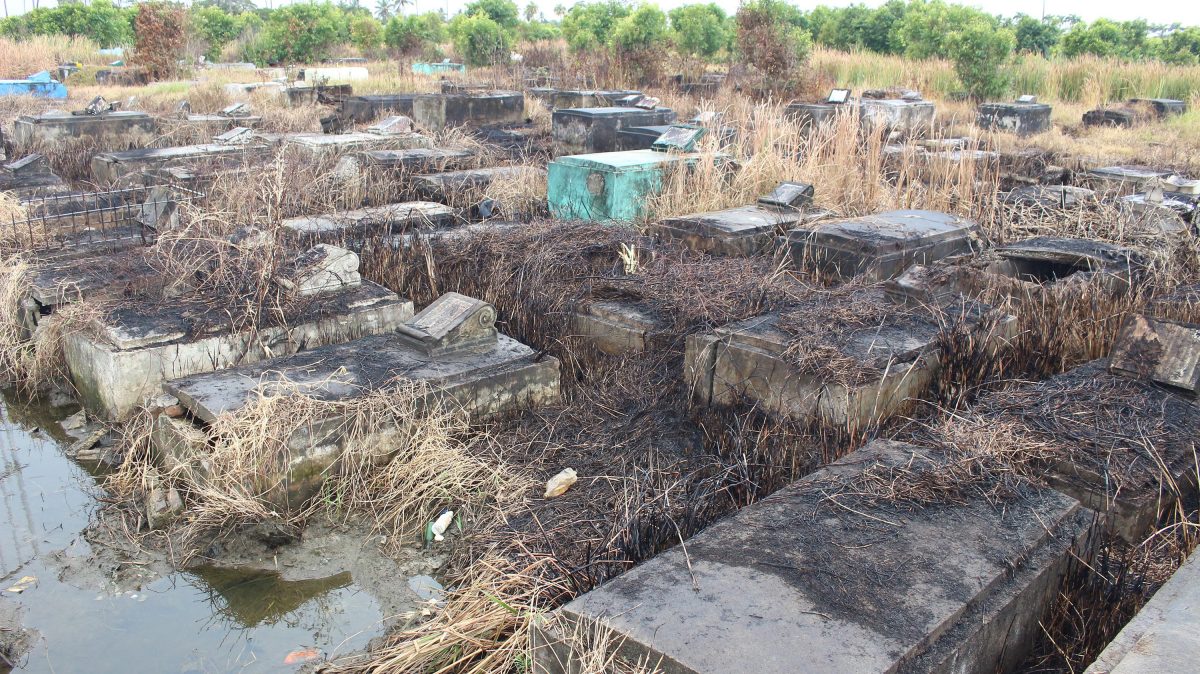After evicting the Dutch, it was the British in 1781 who chose the site of what was later to become this country’s capital, although they did little to translate their vision into reality. The French displaced them in 1782, and they were the ones who first started constructing the infrastructure for a new town which they were to call La Nouvelle Ville. They were not here for long, however, and when the Dutch returned in 1784, they renamed it Stabroek after the President of the Dutch West India Company, who rejoiced in the grandiloquent title of Nicolas Geelvinck, Lord of Castricum, Backum and Stabroek.
While the living were taken into consideration in the very first years of the town’s existence, it is not really known what arrangements were introduced before 1785 to cater for ordinary members of the public, free or enslaved, who had died. We can be more confident, however, about where the white population of status was laid to rest. Stabroek was surrounded by plantations, the front lands of which eventually came to accommodate a number of suburbs which in 1812 were combined with Stabroek to form Georgetown. Each of these estates had its own burial ground where the planters, their friends, anyone of note as well as a very few African servants, either enslaved or free, were interred.
For the most part these have disappeared under the city’s streets and buildings with the exception of two. One is that which once belonged to Le Repentir plantation, and is now incorporated within Georgetown’s present-day cemetery of that name, although it is highly unlikely that anyone nowadays could identify the precise spot where it is located. The other is Bourda, the burial ground for Plantation Vlissengen, which a previous government allowed to be vandalised and fall into a state of disrepair, apparently with a view to driving a road through it. The City Council had also tried to implement the same plan at an earlier stage, but had been prevented from doing so by a court injunction secured by the Guyana Heritage Society in 1992. That injunction served to stymie subsequent government schemes which had the same objective.
The 19th century historian James Rodway suggested that a group of palm trees near the Deanery indicated the site for the burial ground of La Bourgade Plantation, but since the palm trees have long gone, it is impossible to say at this point precisely where it might be found. In addition, he says that St Sidwell’s Church now occupies part of the Werk-en-Rust Plantation graveyard, although in his view this particular burial ground was probably not utilised much.
After 1785 anyone who did not come from the white upper echelons of the society, could expect that on their demise they would be interred in the new town cemetery. It is Rodway again who writes that a law of that year forbade burials within the precincts of Stabroek itself, and identified the Company Path* which separated the estates of La Bourgade and Eve Leary for a township burial ground. This is where the Railway terminus later came to be built, and its earlier associations are probably responsible for the traditions which persist into modern times that the area is haunted.
The sexton, who also doubled as the schoolmaster, and had the duty of interring the dead in the new Stabroek cemetery, grumbled to the authorities in 1791 that it was not a suitable site because he could not transport bodies there in the rainy season. He thought that another location should be chosen instead at the back of the town. The Court of Policy, however, was not about to indulge him where this was concerned, and instead allocated him a punt, as well as giving him an African boy to help in his work.
As it turned out the site was indeed unsuitable, possibly for a number of reasons, and by 1797, the situation had reached something of a crisis point. According to Rodway, in January of that year the attorney of Werk-en-Rust Plantation offered 8¾ acres of land for the purposes of a cemetery if the Court of Policy was prepared to pay 20,000 guilders. The Court must have baulked at the cost, because in the end he had to settle for half that sum. Even then the money was not paid immediately, since he was informed that he would have to wait until the Treasury had enough funds.
The grave-digger by this time was a man named JH Silvold, and he was instructed to prepare the ground and divide it into sections for whites, free coloureds and the enslaved. On September 1st 1797, it was announced that it was now ready, and burials anywhere else were prohibited, the fine for transgression being 500 guilders, a not inconsiderable sum at the time. As it was, Werk-en-Rust remained the town cemetery for more than half a century, its only identifiable section today being the land around St Philip’s Church, which was built on a small part of the burial ground after it was closed.
There is not much clarity about persons of note or interest who were interred there down the decades, although it is known that this was where the Rev John Smith found his final resting place. After being handed a death sentence by a military court following the 1823 uprising, he was given a pardon by the king. Before that arrived, however, he died in prison of TB and was buried in Werk-en-Rust cemetery in an unmarked grave.
If the authorities of an earlier generation thought they had problems with the complaints of the sexton cum schoolmaster of the Stabroek cemetery, these shrank into insignificance in comparison with their exchanges with the last sexton of its Werk-en-Rust successor. The problem became a public issue because by 1846 the cemetery was no longer fit for purpose. With the increase in population over the years, it could now not accommodate all the deceased who needed to be buried there, and Rodway says it was described as a “nuisance” in the Court. Tombs were broken down in order to make room for new burials, and the ground itself was not maintained.
It was not because there was no one charged with the responsibility of upkeeping the cemetery that it was not maintained. According to Rodway, there was a sexton, a Paul Paris Massiah, who was said to be paid a fee of either £500 per year or twice that amount – no one apparently was too sure about the exact sum. In addition, he ran an undertaking business on the side, charging $5.50 for each interment, an exorbitant amount in those days for one of the poorer citizens. Vlissengen was briefly considered as the site for a new cemetery, but the idea was abandoned, in part because it lay to the windward of the most populated section of the city, and Le Repentir was settled on instead.
Mr Massiah, it seems, was not prepared to relinquish what amounted to a sinecure without compensation. It had not escaped his notice that under the new ordinance which would establish the Le Repentir cemetery he would be required to keep the ground in proper order. The old law for Werk-en-Rust had only mentioned fees, and had not listed the duties which were associated with these. Rodway writes that it moved one Court of Policy member to observe he could not see how a man could have been appointed who took the fees and did nothing for them.
The sexton must have been particularly alarmed to learn that there was some suggestion he should also prepare the Le Repentir ground, and since in addition he did not take kindly to the criticism of his administration of the cemetery, he appealed to the Secretary of State, an appeal which was eventually passed to the Court. Massiah referred, no doubt feelingly, to the hardship which would be involved if he were required to maintain the ground out of his fees, and asked for a pension of £500 per annum if he were to relinquish his post. The Court, no doubt, was anxious to get rid of him, and therefore was disposed to pension him off, although for rather less than what he was demanding. In 1860, therefore, it granted him a pension of £300 a year.
Le Repentir had been one of three estates owned by Pierre Louis de Saffon, who had fled France after killing his brother in a duel. Ever remorseful he had named his plantations Le Regret, La Penitence and Le Repentir – Regret, Penitence and Repentence. As it transpires, Le Repentir is perhaps not an unsuitable name for a cemetery. At the time Rodway was writing at the turn of last century, de Saffon’s own tombstone could still be identified in the burial ground. One doubts very much that it has survived into modern times, since Le Repentir has fared no better than Werk-en-Rust before it – in fact, it has done considerably worse.
It was established in 1860, and in a fateful move the Court gave control of it to the Town Council (later City Council), which for a long time has not had the resources to discharge its responsibilities in relation to it. The whole area of the former plantation was not taken up initially, but was prepared in sections, and expanded according to the need for more space.
More than a century ago Rodway referred to the “sorry condition of the churchyards and burying grounds everywhere.” He went on to say that “Those who know the English cemeteries are shocked to see what we have here. And this is all the more conspicuous when it is considered, that enormous expenses have been incurred in connection with Le Repentir.”
One can only wonder what he would have said about the current state of the city cemetery.
* A stretch of land between each plantation was reserved to the Dutch West India Company and was known as the Company Path. A portion of one of these still survives in Georgetown under that name. It probably separated Plantations La Bourgade and Vlissengen.









